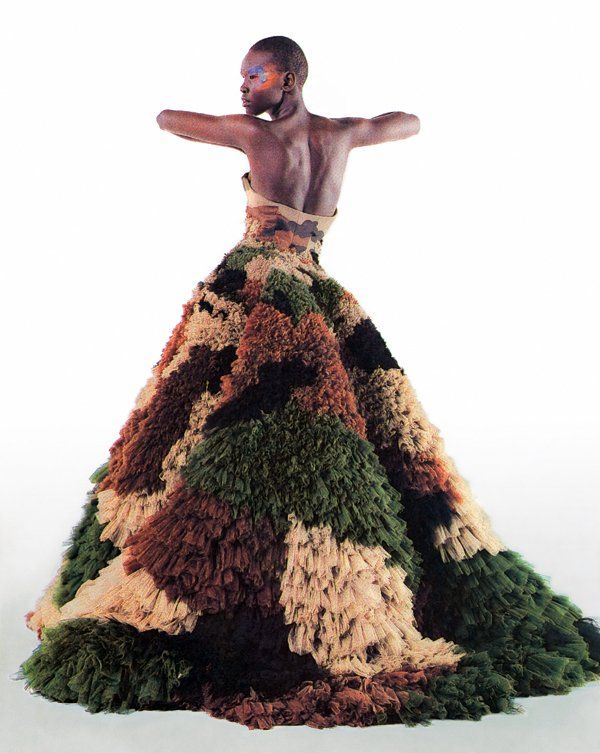
Fashion designers find inspiration in a variety of places: classical paintings, the beats of an audacious musician, or the eccentricities of a friend-cum-muse. Almost all designers, however, claim to have been inspired by the streets. But only Jean Paul Gaultier, who debuts his fall haute couture collection July 6 in Paris, regularly gives the messy realities of daily life unfettered access to his runway. Tattoo body art, Hasidic Jewish traditions, the noble turbans of African immigrants, and the retro-cool of Harlem have all moved the French designer.
He championed nontraditional beauties—with Modigliani faces, Cyrano de Bergerac noses, Rubenesque bodies—long before Dove's "Real Beauty" ad campaign. He put plus-size ladies on his runway before the Internet's self-proclaimed "fat-shionistas" voiced righteous indignation at being marginalized by the frock trade.
The unique and far-reaching cultural resonance of his work is on display in The Fashion World of Jean Paul Gaultier: From the Sidewalk to the Catwalk, an exhibition that opened June 17 at the Montreal Museum of Fine Arts and runs through Oct. 2. (It later travels to the Dallas Museum of Art and San Francisco's de Young Museum.) The Gaultier exhibition follows the well-received Alexander McQueen retrospective at the Metropolitan Museum of Art in New York. And while comparison is inevitable between these two highly skilled designers, each of whom delighted in leaving an audience agitated and unnerved, it would be unfair. McQueen looked inward—guided by his own dark thoughts, painful insecurities, and obsessions. Gaultier looks outward at the swirl of life that engulfs him. And he is fully and optimistically engaged with it.
Gaultier "shows us a society in which we'd like to live—one that's tolerant in ways that go beyond fashion," said museum director Nathalie Bondil at the exhibition's opening.
Through his work, we learn less about Gaultier and more about the times and circumstances in which we all live. He delineates the place religious fervor occupies within modern cities but holds fast to the belief that religious attire, while a symbol of devotion, is ultimately just so much cotton and wool—no more and no less sacred than any other garment. Is he right? At a time when a head wrap, a robe, a veil have taken on such weighted meaning, Gaultier's Hasidic collection from 1993 is another entry point for asking difficult questions about faith, propriety, and modern life.
The most casual pop-culture observer will recognize his collaborative efforts with Madonna through the 1990s, when he transformed cone bras into an aesthetic expression, a feminist protest, and a sexual provocation. Gaultier's interest in the transformative powers of lingerie reaches back to his childhood. As evidence, the exhibition includes a matted teddy bear onto which the young Gaultier had stitched a rudimentary little brassiere. (As a boy, he was either a design savant or quite an odd duck—perhaps both.) His exquisitely constructed and shape-shifting corsets on exhibit continue to be relevant as we struggle with our definitions of female beauty.
Gaultier's multicultural inspiration, which spans the entire breadth of his career, beginning in 1976, reminds us of the beauty of cultural diversity. But his kitschy love affair with French cultural icons—from the cancan and the Eiffel Tower to his famous patron, Catherine Deneuve—mark him as a nationalist. In the frothy realm of fashion, no other designer is so devoted to exploring the links between aesthetics, populations, and politics.
Gaultier's career has spanned three decades, during which he has been a rebel as well as a member of the establishment, spending seven years as creative director of Hermès—a position he left in 2010. He has created costumes for film and stage, but his work rarely makes an appearance on the red carpet. Perhaps it's just too fraught with meaning.
At 59, Gaultier has been adamant that this exhibition is not a retrospective, not a final bow. But it's hard not to look at the more than 100 ensembles, along with photographs and film clips, and not wonder if Gaultier's most volatile, most searing, work is behind him. In recent seasons, he has mocked the industry's fat phobia and the foibles of the bourgeoisie—lightweight topics from a man who once challenged the veracity of gender roles.
But perhaps age brings a certain calm. The designer's work no longer shouts and shocks. At this career midpoint, Gaultier only asks for our thoughtful consideration. And suggests that everyone—from the immigrant to the religiously devout to the middle-class striver—deserves the same.
Uncommon Knowledge
Newsweek is committed to challenging conventional wisdom and finding connections in the search for common ground.
Newsweek is committed to challenging conventional wisdom and finding connections in the search for common ground.





